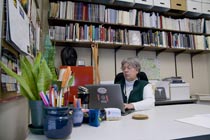
Handy Links
SLAC News Center
SLAC Today
- Subscribe
- Archives: Feb 2006-May 20, 2011
- Archives: May 23, 2011 and later
- Submit Feedback or Story Ideas
- About SLAC Today
SLAC News
Lab News
- Interactions
- Lightsources.org
- ILC NewsLine
- Int'l Science Grid This Week
- Fermilab Today
- Berkeley Lab News
- @brookhaven TODAY
- DOE Pulse
- CERN Courier
- DESY inForm
- US / LHC
SLAC Links
- Emergency
- Safety
- Policy Repository
- Site Entry Form

- Site Maps
- M & O Review
- Computing Status & Calendar
- SLAC Colloquium
- SLACspeak
- SLACspace
- SLAC Logo
- Café Menu
- Flea Market
- Web E-mail
- Marguerite Shuttle
- Discount Commuter Passes
-
Award Reporting Form
- SPIRES
- SciDoc
- Activity Groups
- Library
Stanford
Around the Bay
Presenting the Past
 SLAC Archivist Jean Deken is aware of only one archivist joke: Why is it good if one archivist marries another? The punch line: the older they get the more interested they'll get in each other.
SLAC Archivist Jean Deken is aware of only one archivist joke: Why is it good if one archivist marries another? The punch line: the older they get the more interested they'll get in each other.
"Of course, the implication is that we're only interested in old stuff," said Deken, who just happens to be married to a fellow archivist. "It's typical for an archivist to be wrapped up in history. That's our story."
Deken got wrapped up in history after taking a job at the Missouri Botanical Garden Library. In the corner of her building, she noticed a pile of materials that everyone tried to ignore.
As the newest employee, Deken was the one sent to fetch materials from these piles. She soon discovered more; there were piles collecting dust in closets, piles being soiled in greenhouses and even piles being "bird nested" in a tower.
"I thought this stuff was fascinating," she said. "There were manuscripts written by the garden's founder and scientific advisor, and hand-drawn blueprints of the garden's landscape."
Organizing these unique materials gripped her attention. Deken started combing through them. Others took notice, and pulled more stuff out for her to sort. She was hooked.
When Deken arrived at the National Archives in St. Louis in 1978, she drifted away from unique materials to work mostly with income tax returns. Forms poured in during tax season—25 to 30 semi-trailer loads worth.
But when the Clinton Administration commissioned government sectors to recognize the 50th anniversary of WWII, Deken reconnected with history. She compiled information on the civilian war effort for an exhibition that featured the national laboratory system's predecessor, the Office of Scientific Research and Development. Her interest in science history was reignited.
"I realized I needed to be with the people who were creating the records," she said. "Not somewhere where I was waiting for the records to come to me."
When Deken arrived at SLAC in 1996, she was commonly asked if she knew it hosted the first World Wide Website in the U.S. Interested in validating the claim, she sought documentation of the milestone. There was none, which wasn't surprising because the Web was only six years old at the time.
As Deken continued to dig, she tried to engage people involved with the early website—but her queries were often met with nonchalance. Nobody seemed to care too much until a media account implied another lab had been the first. Then in came the calls and e-mails urging her to set the record straight.
That's when everything clicked. After a few years of work, the threads of SLAC's historic web pages were assembled into a small but well-processed collection of documentation and a related online exhibit which was completed in time for the 10th anniversary of the web in 2001.
"It's hard to get people's attention sometimes, especially about the past," said Deken. "People focus on today's project and tomorrow's proposal, but we can't let the accomplishments of SLAC be forgotten."
—Matt Cunningham, SLAC Today, February 27, 2008
Above image: Archivist Jean Deken makes SLAC's history her business.